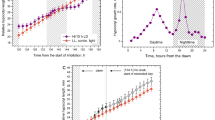Abstract
The diurnal and circadian expression of light-harvesting genes (Lhc) is well documented for many plant species of the ‘Angiospermae’ division. Here we present the diurnal mRNA levels of species of the Gymnospermae, Pteridophyta, Bryophyta and Phycophyta divisions. Except for four Coniferophytina species, diurnal Lhc mRNA accumulation is detected in fern, moss and algae, supporting the idea that the concept of ‘circadian clock’-controlled gene expression is an ancient process. Possible reasons why plants need the ‘circadian clock’ control mechanism are discussed.
Similar content being viewed by others
References
Alosi MC, Neale DB, Kinlaw CS: Expression of cab genes in douglas-fir is not strongly regulated by light. Plant Physiol 93: 829–832 (1990).
Canovas F, McLarney B, Silverthorne J: Light-independent synthesis of LHC IIb polypeptides and assembly of the major pigmented complexes during the initial stages of Pinus palustris seedling development. Photosyn Res 38: 89–97 (1993).
Chang S, Puryear J, Cairney J: A simple and efficient method for isolating RNA from pine trees. Plant Mol Biol Rep 11: 113–116 (1993).
Gagne G, Guertin M: The early genetic response to light in the green unicellular alga Chlamydomonas eugametos grown under light/dark cycles involves genes that represent direct responses to light and photosynthesis. Plant Mol Biol 18: 429–445 (1992).
Hoober JK, White RA, Marks DB, Gabriel JL: Biogenesis of thylakoid membranes with emphasis on the process in Chlamydomonas. Photosyn Res 39: 15–31 (1994).
Klekowski EJ: Reproductive biology of the pteriodophyta. III. A study of the Blechnaceae. Bot J Linn Soc 62: 361–371 (1969).
Kojima K, Yamamoto N, Sasaki S: Structure of the pine (Pinus thunbergii) chlorophyll a/b-binding protein gene expression in the absence of light. Plant Mol Biol 19: 405–410 (1992).
Long Z, Wang SY, Nelson N: Cloning and nucleotide sequence analysis of genes coding for the major chlorophyll-binding protein of the moss Physcomitrella patens and the halotolerant alga Dunaliella salina. Gene 76: 299–312 (1989).
LaRoche J, Mortain-Bertrand A, Falkowski PG: Light intensity-induced changes in cab mRNA and light harvesting complex II apoprotein levels in the unicellular chlorophyte Dunaliella tertiolecta. Plant Physiol 97: 147–153 (1990).
Meyer H, Thienel U, Piechulla B: Molecular characterization of the diurnal/circadian expression of the chlorophyll a/b-binding proteins in leaves of tomato and other dicotyledonous and monocotyledonous plant species. Planta 180: 5–15 (1989).
Nevo E, Meyer H, Piechulla B: Diurnal rhythms of the chlorophyll a/b-binding protein mRNAs in wild emmer wheat and wild barley (Poaceae) in the Fertile Crescent. Plant Syst Evol 185: 181–188 (1993).
Oberschmidt O, Kim S, McGrath M, Jansco M, Bassi R, Piechulla B, Pichersky E: Genes of two types of fern Lhcb proteins are under the control of a circadian rhythm, manuscript submitted.
Pichersky E, Bernatzky R, Tanksley SD, Breidenbach RW, Kausch AP, Cashmore AR: Molecular characterization and genetic mapping of two clusters of genes encoding chlorophyll a/b-binding proteins from Lycopersicon esculentum (tomato). Gene 40: 247–258 (1985).
Piechulla B, Pichersky E, Cashmore AR, Gruissem W: Expression of nuclear and plastid genes for photosynthesis-specific proteins during tomato fruit development and ripening. Plant Mol Biol 7: 367–376 (1986).
Piechulla B: ‘Circadian clock’ directs the expression of plant genes. Plant Mol Biol 22: 533–542 (1993).
Reski R, Faust M, Wang XH, Wehe M, Abel WO: Genome analysis of a moss, Physcomitrella patens (Hedw.) B.S.G. Mol Gen Genet 244: 352–359 (1994).
Riesselmann S, Piechulla B: Diurnal and circadian light harvesting complex and quinone B-binding protein synthesis in leaves of tomato (Lycopersicon esculentum). Plant Physiol 100: 1840–1845 (1992).
Sambrook J, Fritsch EF, Maniatis T: Molecular Cloning: A Laboratory Manual. Cold Spring Harbor Laboratory Press, Cold Spring Harbor, NY (1989).
Sitte P, Ziegler H, Ehrendorfer F, Bresinsky A: In: Lehrbuch der Botanik für Hochschulen. Strasburger E, Noll F, Schenck H, Schimper AWF. p. 712 Gustav Fischer Verlag. Stuttgart Jena New York (1991).
Stahl E: Das Nichtergrünen etiolierter Pflanzenteile. In: Zur Biologie des Chlorophylls, Laubfarbe und Himmelslicht; vol. 9 pp. 113–126, Gustav Fisher Verlag, Jena (1909).
Yamamoto N, Mukai Y, Matsuoka M, Kano-Murakami Y, Tanaka Y, Ohashi Y, Ozeki Y, Odeni K: Light-independent expression of cab and rbcS genes in dark-grown pine seedlings. Plant Physiol 95: 379–383 (1991).
Author information
Authors and Affiliations
Additional information
Dedicated to Dr H. W. Heldt on the occasion of his 60th birthday.
Rights and permissions
About this article
Cite this article
Oberschmidt, O., Hücking, C. & Piechulla, B. Diurnal Lhc gene expression is present in many but not all species of the plant kingdom. Plant Mol Biol 27, 147–153 (1995). https://doi.org/10.1007/BF00019186
Received:
Accepted:
Issue Date:
DOI: https://doi.org/10.1007/BF00019186




